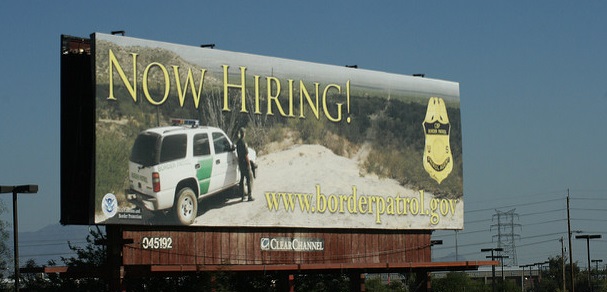When President Trump signed three immigration executive orders in January of this year, much of the attention was focused on the travel ban and border wall. But within those orders is another proposal that is equally troubling: his call for hiring 5,000 additional Border Patrol agents and 10,000 additional Immigration and Customs Enforcement (ICE) officers. It is unclear if this growth in staffing is prudent given the last time the Department of Homeland Security (DHS) received a large infusion of new hires, cases of corruption and misconduct spiked in the agency.
The many concerns regarding this proposal to hire thousands of new agents and officers are the focus of a new paper by Professor Josiah Heyman.
Heyman explains that the number of border and interior enforcement personnel stands at more than 49,000 today. Border Patrol saw their numbers double from Fiscal Year (FY) 2003 to 2016, with an additional 8,000 agents added between 2006 and 2009. This brought their total number of agents to a staggering 20,119. ICE likewise experienced massive growth during this time, nearly tripling in size from FY 2003 to 2016.
Serious problems followed this spike in hiring. After the 2006-2009 Border Patrol surge, “the number of employees arrested for misconduct, such as civil rights violations or off-duty crimes like domestic violence, grew each year between 2007 and 2012, reaching 336, a 44 percent increase,” Heyman’s paper notes. “Over the last 10 years, almost 200 employees and contract workers of the Department of Homeland Security have taken nearly $15 million in bribes while being paid to protect the nation’s borders and enforce immigration laws.”
According to agency documents and court records, “dozens of [ICE] agents and contract guards responsible for the detention and removal of undocumented immigrants have been arrested and charged with beating people, smuggling drugs into detention centers, having sex with detainees and accepting bribes to delay or stop deportations.”
The widespread recruitment problems resulting from the 2006-2009 Border Patrol growth spurt led to important reforms in CBP, including the Anti-Border Corruption Act of 2010. The added measures include mandatory polygraph testing, but notably, it was not required for ICE applicants. In many cases, these polygraph examinations revealed CBP applicants’ troubling backgrounds, including “10 applicants believed to have links to organized crime who had received sophisticated training on how to defeat the polygraph exam.”
According to other recent reports, two-thirds of Border Patrol applicants failed the test; a somewhat higher percentage (40 percent) passed previously, according to a 2012 Government Accountability Office (GAO) study. CBP data show a 50 percent Border Patrol candidate failure rate on the written test, 15 percent failure before the oral hiring board, 25 percent medical failure test, 15 percent failure on the physical fitness test, and 56 percent failure on the background check.
ICE does not currently require its applicants to pass a polygraph test. Even worse, a 2016 report from the DHS Office of Inspector General found that both CBP and ICE have systemic inadequacies that delay the hiring process and fail to track applicants, which could further complicate and hamper any expansion efforts.
Without better hiring practices put in place and safeguards against the many problems associated with rapid hiring surges at the immigration enforcement agencies, Congress should not allow for this rapid surge in hiring. It does not make America safer, and in fact may be making us less so.
Photo by Quinn Dombrowski
FILED UNDER: border patrol, featured, immigrations and customs enforcement


